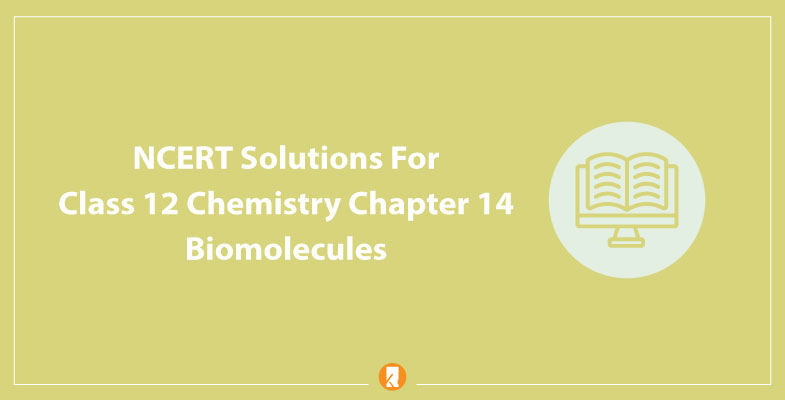The NCERT Solutions for Class 12 Chemistry Chapter 14 Biomolecules are designed for students in Class 12 who are preparing for their CBSE Class 12 board exams. Biomolecules are the focus of Class 12 Chemistry Chapter 14, which includes questions and solutions on topics such as saccharides, glycogen, cellulose, starch, and more. Answers to the textbook question are included in the Biomolecules solutions pdf, as well as other Chemistry 12 Important Problems, worksheets, MCQs, HOTS (Higher Order Thinking Skills), and example questions developed by KopyKitab’s experts.
- All you need to know about: Class 12 Chemistry NCERT Solutions
NCERT Solutions For Class 12 Chemistry Chapter 14 PDF: Biomolecules
Class 12 Chemistry Chapter 14 NCERT Solutions PDF
Download Class 12 Chemistry Biomolecules NCERT Solutions PDF
Biomolecules are organic chemicals found in various cells of a live creature as vital elements. Carbohydrates, proteins, enzymes, vitamins, and nucleic acids are examples of biomolecules. We have supplied a downloadable form of Class 12 Chemistry Chapter 14 NCERT Solutions PDF to assist students in becoming familiar with the themes. This PDF will assist students in achieving good grades.
Class 12 Chemistry Biomolecules NCERT Solutions PDF – Important Questions
- Write two main functions of carbohydrates in plants?
- Classify the following into monosaccharides and disaccharides?
Ribose, 2-deoxyribose, maltose, galactose, fructose and lactose. - Define glycosidic linkage?
- What are the hydrolysis products of (i) sucrose and (ii) lactose?
- What happens when D-glucose is treated with the following reagents?
(i) HI (ii) Bromine water (iii) HNO3 -
Differentiate between globular and fibrous proteins?
What will you get in Class 12 Chemistry Chapter 14 NCERT Solutions PDF?
In solutions for class 12 Chemistry chapter 14 Biomolecules, the students will study carbohydrates that cannot be hydrolyzed further to give a simpler unit of polyhydroxy aldehyde or ketone. They will get to know that the carbohydrates that yield a large number of monosaccharide units on hydrolysis are known as polysaccharides. Carbohydrates may also be categorized as reducing or non-reducing sugars. All those carbohydrates which reduce Fehling’s solution and reducing sugars are referred to as Tollens’ reagent.
Subtopics of Class 12 Chemistry Chapter 14 – Biomolecules
- Carbohydrates
- Proteins
- Enzymes
- Vitamins
- Nucleic Acids
- Hormones
Marks Weightage of NCERT Solutions for Class 12 Chemistry Chapter 14
| Name of Chapter | Marks Allotted |
| Chapter 14: Biomolecules | 4 |
Other Important Links Related To Class 12 Chemistry
Here you can check links to various study materials related to the 12th Chemistry:
Benefits of NCERT Solutions For Class 12 Chemistry Chapter 14 PDF
The following are some of the advantages of biomolecules as stated in the Biomolecules Class 12 NCERT PDF:
- It gives you a comprehensive overview of the chapter.
- It’s useful for revising because all of the important points are provided in a simple manner.
- A biomolecule is a difficult subject that is discussed in a straightforward and understandable manner.
- It is a great practice paper because it lays out the question format of board exams.
- Removes any uncertainties that may have arisen while reading the chapter.
- Not only does it aid in the preparation of board exams, but it also aids in the preparation of other competitive undergraduate exams.
We have covered the detailed guide on CBSE 12th Chemistry NCERT Solutions Chapter 14. Feel free to ask any questions in the comment section below.
FAQs on NCERT Solutions For Class 12 Chemistry Chapter 14
What are Biomolecules in Chapter 14 of NCERT Solutions for Class 12 Chemistry?
Organic molecules which are important for various metabolic processes like cell repair, digestion, growth, etc. are called biomolecules.
What are the types of Biomolecules discussed in Chapter 14 of NCERT Solutions for Class 12 Chemistry?
Lipids, proteins, nucleic acids, and carbohydrates are the four types of biomolecules. Along with these many biomolecules are involved in carrying out metabolic activities.
What are the benefits of Class 12 Chemistry Chapter 14 Biomolecules solution?
Go through the above article for the list of benefits of using NCERT Solutions For Class 12 Chemistry Chapter 14 PDF.
Explain the difference between glycogen and starch?
In animals, carbohydrates are stored in the form of glycogen which is a polysaccharide. Similarly, starch is composed of two components namely amylose and amylopectin. Even though starch and glycogen are forms of carbohydrates, glycogen is made up of only one component. The glycogen structure is more branched than that of amylopectin.
Where can I download NCERT Solutions For Class 12 Chemistry Chapter 14 Biomolecules PDF?
You can download NCERT Solutions For Class 12 Chemistry Chapter 14 Biomolecules PDF from the above blog.
Can students rely on NCERT Solutions for Class 12 Chemistry Ch 14?
Yes, students can rely on the NCERT Solutions for Class 12 Chemistry Chapter 14. Subject experts prepare these solutions based on CBSE guidelines and exam patterns. Each solution is provided with structures and chemical formulas to help students understand the concepts intuitively.
What are the topics in Class 12 Chemistry Chapter 14 Biomolecules Solution?
Go through the above blog for the list of topics in Class 12 Chemistry Chapter 14 Biomolecules Solution.
